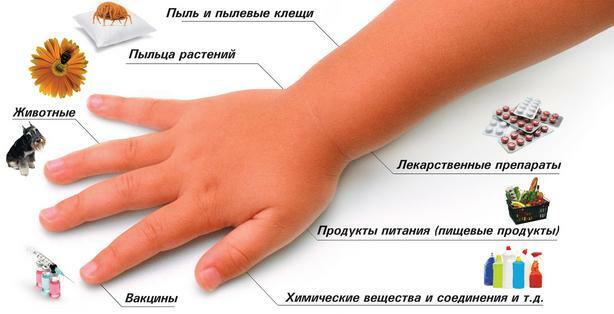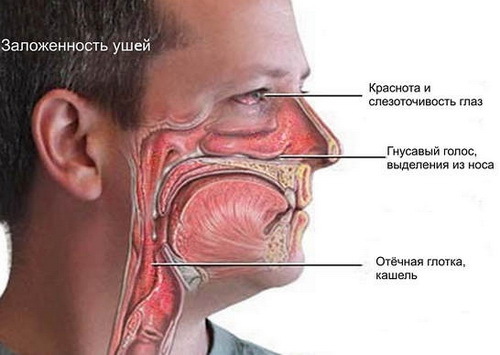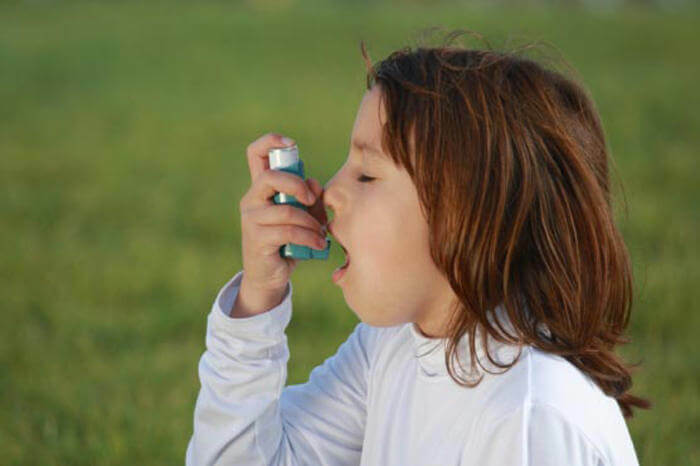Top-7 allergens in our home and how to prevent an allergic reaction

Conjunctivitis, bronchial asthma, rhinitis, dermatitis - these allergic diseases become too common, often doctors note that such allergic manifestations attack whole families!It turns out that most allergens that provoke the development of allergic rhinitis, dermatitis, bronchial asthma and conjunctivitis are present in every home - getting rid of them, taking certain precautions, you can avoid deterioration of health.
Contents: Allergen No. 1 - household dust Allergen №2 - mold Allergen №3 - pets Allergen №4 - household chemicals Allergen №5 - paint and varnish materials Allergen №6 - house plants Allergen №7 - latexAllergen №1 - household dust
Even if you regularly clean the house, maintain literally the perfect cleanliness, household dust will be present.It invisibly accumulates in various parts of the house - on shelves, in books, soft toys, home textiles, bedding and on furniture.To get rid of household dust is impossible, because people are its "producers" themselves: in the allergen were found flower pollen, dead particles of epidermis, scales of hair, dandruff, mineral components, particles of cellulose, chitinous particles of pet shells, pet hair, mold,Bacteria and other components.
All listed components of household dust can cause a person an allergic reaction, which will be expressed by the following syndromes:- conjunctivitis;
- runny nose;
- skin itching;
- sneezing;
- rash on the skin and mucous membranes;
- cough( dry, spastic);
- development of eczema.
These symptoms of an allergic reaction are present in humans all year round, especially evident in autumn and winter, which is explained simply - a person is forced to spend most of the time indoors, and not on the street.
The most dangerous manifestation of allergy to household dust is bronchial asthma, and this disease can be provoked by dust itself and other manifestations of allergy( for example, infamous rhinitis).Therefore, doctors recommend not to ignore the common cold in the mornings, periodically appearing hives or lacrimation during cleaning of premises - these phenomena already have an occasion to visit an allergist.
To reduce the risk of allergy to household dust, several rules must be followed:
-
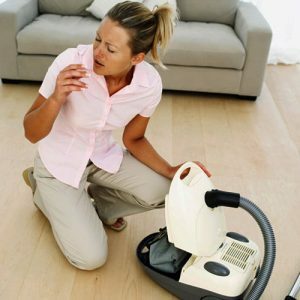 The house needs to reduce the number of places where dust can accumulate.It is understood that you will have to remove carpets, curtains to replace with blinds, change soft furniture to leather, change books and soft toys into glazed cabinets, minimize the presence of heavy textiles in the interior.
The house needs to reduce the number of places where dust can accumulate.It is understood that you will have to remove carpets, curtains to replace with blinds, change soft furniture to leather, change books and soft toys into glazed cabinets, minimize the presence of heavy textiles in the interior. - The sleeper should be organized competently.A familiar mattress is better to replace - it probably already accumulated a lot of dust, so it is advisable to buy a product that can be easily cleaned in a non-chemical way.On the new mattress, you need to put on a cover that completely covers it, and replace the feather and down pillows with products with synthetic filler.
- Every day you need to shake out blankets, pillows and bedspreads.When choosing a blanket, preference should be given to products from easily washable fabrics and without lint.Bedding should be washed twice a week, using special means that can destroy dust mites.
- Every 2-3 years, you need to change the pillows, the mattress should be replaced once in 8-10 years.
- Daily it is necessary to conduct a wet cleaning at home - wash floors, wipe dust from furniture and other interior items with a damp cloth.
- Be sure to take care of additional cleaning of the air in the premises - install air purifiers, ionizers, air conditioners with humidification system.Only the filters need to be changed regularly in these devices to have an effect.
If the above measures do not help to cope with the allergy and household dust provokes worsening of the condition, the doctors will prescribe desensitizing agents and specific drugs that will relieve the unpleasant allergy symptoms.In particularly severe cases, patients are administered corticosteroid drugs.
Allergen No. 2 - mold
Mold present in the house causes the strongest allergic reaction, moreover, more than 20 varieties of mold fungi are known, which adversely affect human health. Any of the types of mold fungi is an aggressive allergen, the following symptoms appear when inhaled:
-
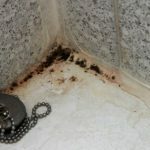 shortness of breath and shortness of breath;
shortness of breath and shortness of breath; - conjunctivitis;
- cough;
- itching of the skin, small red rashes - hives;
- sneezing attacks;
- runny nose.
In addition, a person who has an allergy to a mold can complain about nausea and vomiting, regular diarrhea( diarrhea), and recurring pain in the stomach.
Treatment of mold allergy involves taking symptomatic and desensitizing medications. But to obtain the desired result, a number of preventive measures will also be required:
- In the house, it is necessary to constantly monitor the humidity level using a special device.Normal readings are 40-60%.
- During the cleaning in the house, it is especially necessary to clean the places where the accumulation of mold is most likely: bathroom, kitchen, bathroom, ventilation grilles, pantry.For high-quality cleaning of these places it is recommended to use a soda solution( per liter of hot water 3 tablespoons of baking soda) or replace it with special means for fighting mold.Expressed foci of mold should be wiped with a solution of table vinegar( 1 tablespoon per 200 ml of warm water).
- After taking a bath( shower), tile on the walls of the floor in the room must be carefully dried.
- Premises should often be ventilated, and any water leakage should be eliminated as quickly as possible.
- Books should be regularly vacuumed, ventilated, dried in the sun and occasionally irrigated with a 3% solution of hydrogen peroxide( from a spray).
- It is highly desirable to refuse from room flowers.
Allergen №3 - pets
Doctors say that it is often enough to diagnose an allergy to pets, or to be more precise - to a protein that is contained in the particles of their saliva, hair and dandruff.And, it is absolutely not necessary that the domestic pet be fluffy - the allergy will in any case make itself felt.The disease can occur from the first hours of the appearance of the animal in the house, but it can develop much later. Typical symptoms of allergy to pets include:
- Inflammation of the eyes and abundant lacrimation;
- itching of the skin, its redness and the appearance of a rash;
- frequent sneezing and unexplained cold;
- dyspnea on the background of shortness of breath.
 In particularly severe cases, an allergy to a pet can provoke the rapid development of Quincke's edema or anaphylactic shock.
In particularly severe cases, an allergy to a pet can provoke the rapid development of Quincke's edema or anaphylactic shock.
Almost all doctors categorically do not recommend starting a pet to those people who already have bronchial asthma - allergens released to the animal, worsen the patient's condition, asthma will proceed with complications.
According to doctors, most often an allergy appears on cats, but the same inadequate reaction of the body can develop on rabbits, dogs, goats, birds, horses, cows and rodents, in general on any pet!Therefore, the doctors recommend that you exclude close contact with pets - either do not bring them into the house, or( if available) give them in good hands. If this is not possible, the following physician's instructions should be observed:
- The habitat of the animal in the house must be clearly limited.
- As often as possible, let the animal walk in the fresh air.
- Strictly forbid a pet to go into the bedroom, lie on a bed, armchair or tables.
- Bed linen is washed at least twice a week, regularly clean the mattress and clean in any way pillows and furniture covers - the places where the protein released to the animals is able to accumulate.
- In the bedroom, regular drafts, all other rooms just need to be ventilated frequently.
- All carpets and carpet coverings are taken out of the house.
- Wash regularly.
- In the house you need to install a special air cleaner.
In addition, you need to regularly bathe your pet and take care of his health - give him multivitamin complexes, provide proper nutrition.
For the treatment of allergies in pets, antihistamines, symptomatic agents and sorbents are most often used.
Allergen №4 - household chemicals
Those household chemicals that every person contacts daily can cause allergies.The fact is that the components for washing dishes and toilet bowls, floors and tiles and other household chemicals include chemical components, and each of them can become a powerful irritant. The most common allergy manifests itself on:
- formaldehyde - is part of the means for the destruction of mold;
- nitrobenzene - used for preparation of means for polishing floors and furniture;
- phosphates - are contained in virtually all detergent powders and detergents;
- dyes / fragrances / fragrances - are part of every household chemical product;
- Chlorine - used in disinfectants and bleaches.
Allergens that are in household chemicals can affect the body in many ways:
- through the skin: allergens get into the body if a person does not work with household chemicals in gloves;
- through the respiratory tract: small particles of allergens have the property of evaporating from both surfaces and from the laundry.
The first symptoms of allergy to household chemicals( itching and redness of the skin, frequent sneezing and profuse lacrimation, nasal congestion and dry cough, mild headache and drowsiness) should be the reason for visiting an allergist. Only an expert can accurately determine the cause of the allergy and give recommendations for the prevention of its development:
-
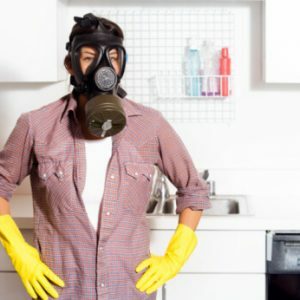 From household chemicals, give preference to hypoallergenic.Such products do not contain phosphates, chlorine, dyes, parabens and flavors.
From household chemicals, give preference to hypoallergenic.Such products do not contain phosphates, chlorine, dyes, parabens and flavors. - It is advisable to use natural remedies for cleaning - for example, mustard, baking soda, vinegar, salt, ammonia or lemon juice.
- When cleaning the house, you need to use rubber gloves, and on your hands, you must always apply a thin layer of protective cream.
- After cleaning, be sure to thoroughly ventilate the premises.
- Completely to refuse hand washing, and on the washing machine always to establish a mode of additional rinsing.
- Cleaning agents in the form of powders should not be used, it is better to give preference to a gel / creamy.
When medically treated with allergies to household chemicals, the doctor prescribes antihistamines, symptomatic agents, creams / ointments based on corticosteroid preparations.
Allergen №5 - paint and varnish materials
The fact that low-quality paints contain a lot of potential allergens is known to everyone.But allergy can provoke not only building or finishing materials, but also typographic paint, textile, cosmetic. In this case, the allergy will be manifested by the following symptoms:
-
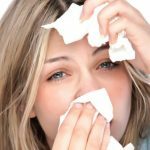 rashes, flaking and redness on the skin;
rashes, flaking and redness on the skin; - Persecution in the throat and cough;
- nausea;
- rubbing in the eyes and copious lacrimation;
- dizziness;
- asphyxiation.
With severe allergies to paintwork materials, it is possible to develop bronchial asthma, collapse, convulsions, eczema and anaphylactic shock.
Quite often, the allergy is provoked by cosmetic hair dyes or decorative nail polish, and such an inadequate reaction of the body with redness, burning and itching of the skin is expressed.In very severe cases, blisters and erosion may appear on the surface of the skin, many people end up with Quinck's swelling or anaphylactic shock.
To minimize the risks of development of the considered allergy, it is necessary to follow the recommendations of specialists:
- Any artistic and painting work should be carried out only in well-ventilated rooms.
- Use gloves when handling any paintwork materials.
- Before using cosmetic paints, make sure to sample on a small area of the skin.
- If possible, refuse to work with materials that can provoke a powerful allergic reaction, it is desirable to replace them with hypoallergenic ones.
Allergen No. 6 - indoor plants
Indoor plants, like any living organism, breathe and release into the air various substances - they can provoke a strong allergic reaction.It should also be taken into account that dust or mold can accumulate on the leaves of indoor plants, which is also an occasion for an inadequate reaction of the body. This proximity to indoor plants can lead to the following symptoms:
- bronchospasm;
- runny nose and sneezing;
- dry cough.
Most often, allergies are caused by plants that release essential oils into the air.These include geranium, pelargonium, hydrangea, ferns, indoor maple, cyclamen, dracaena, primula and many others.To get rid of allergies you need to get rid of the source of the stimulus and undergo treatment with antihistamine drugs( appoints an allergist doctor). To minimize the risk of allergies to houseplants, some rules should be observed:
-
 Carefully choose plants for your home, except those that with great certainty will cause allergies.
Carefully choose plants for your home, except those that with great certainty will cause allergies. - Do not place plants in the bedroom.
- Once a week, remove dust from plant leaves - this can be done with a damp cloth or a warm shower.
- All measures for chemical treatment of indoor plants are carried out on the street or on the balcony.
Allergen No. 7 - latex
Latex is found in a large number of objects that surround a person - toys, rugs, chewing gums, gloves, hosiery, condoms, laundry rubbers and much more.It is latex that can cause a strong enough allergy, which will manifest as shortness of breath, itching and swelling of the skin, nasal congestion and itchy eyes. In particularly severe cases, latex provokes a more powerful allergic reaction of the body:
- heart palpitations or sudden slowing of the pulse;
- severe swelling of the tongue, lips, face, neck and / or genitals;
- sharp decrease in blood pressure;
- faintness, blue lips;
- apathy or, on the contrary, excessive nervous excitability.
Allergy to latex can occur immediately after contact with the product, or after a few hours.It is noteworthy that people with allergy to latex have an allergy to cherries, potatoes, bananas, kiwi and peaches, avocados and nuts.The fact is that both in latex and in the listed foods contain the same protein - it is he who provokes allergies.
To exclude allergy to latex, you just need to prevent any contact on the products from it.And to restore the body with symptoms of developing allergies can antihistamines, symptomatic drugs.
Allergens in our home are everywhere and everywhere.You can try and exclude them from everyday life, you can endlessly establish order and refuse to use chemicals.But what about the outside world?Here, allergists will come to the rescue - they will not only accurately find out which stimulus has a negative effect on the body, but will also prescribe an effective treatment.
Tsygankova Yana Aleksandrovna, medical reviewer, therapist of the highest qualification category

